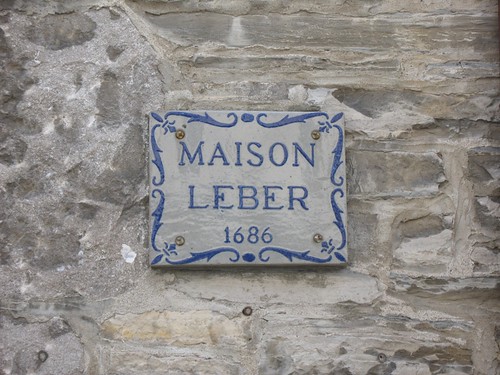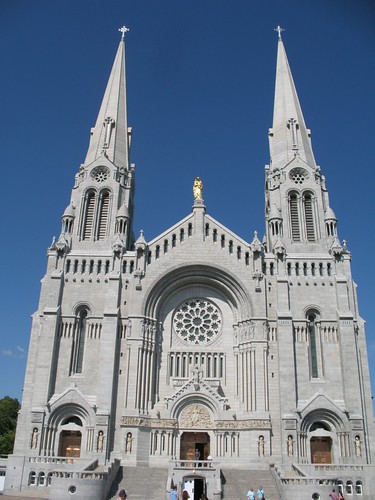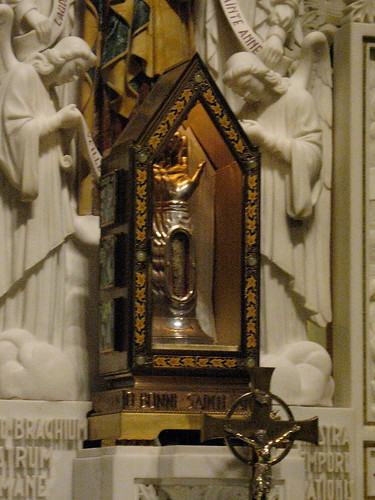Quebec (the province and the city) has a lot of history. In Vancouver, “old” just means turn of the century (Gastown, some of Strathcona and New Westminster). But Vieux-Québec? Try turn of the eighteenth century, then we’ll talk. Everything just feels old, every street corner has a hundred stories to tell.
Most of that history is Catholic. Half the streets are named after saints, many of the historical buildings are churches, convents, presbyteries and so on. Every aspect of French-Canadian history is soaked in religious tradition. I don’t especially mind, when I see it purely as history. As much as I despise organised religion in general, and the Catholic Church in particular, it has inspired some beautiful art and architecture.
Mind you, Quebec’s not as religious as it used to be. A lot of these traditions are dying off, and so are the communities. Just as an example, Île-d’Orléans used to contain six parishes, one for each village, each with its own church and presbytery (where the religious folks lived). And maybe school, too, although I’m not sure about that. About twenty years ago, those six parishes were merged into two. Nowadays, there’s only one priest to serve the entire island, assisted by one other priest from the mainland to hold services at all the churches on the weekend. Which, let’s face it, is not a big trek, but still. It’s a hell of a change in just a couple of generations.
Many cash-strapped religious orders have also sold off buildings and property, which have been converted to other uses. Just as a for instance, the former presbytery of Sainte-Famille, Île-d’Orléans, is now a genealogy museum. Not to mention that Anglican church in Strathcona, converted to an art studio. A big improvement in both cases, I think.
We had dinner with a family friend, a parish priest in downtown Quebec who used to be assigned to our parish in Ottawa. He had some fun stories about the Dominican order’s internal politics, at the local and provincial level. But also stories of shrinking, and aging, flocks as well as priest communities themselves. Part of me felt a little sad for him. It can’t be easy to see your community and your whole way of life implode like that in his lifetime. As much as I believe the world is better off with less oppressive tradition, dogma and blind faith, it’s nothing personal. This friend of ours, he’s good people, and though I don’t respect his beliefs I respect the fact that they’re important to him.
One of the upsides is that nowadays, and especially for children, religious differences are not such a big deal anymore. As the bonds of faith are breaking down, so have the walls between faiths. We visited an Anglican church in Vieux-Québec: Holy Trinity Cathedral (the first Anglican cathedral built outside the British Isles, dating from 1804). There happened to be a gaggle of schoolkids on a field trip, and a guide (or the teacher, maybe) was explaining to these presumably Catholic children some differences between Catholicism and Anglicanism. For one thing, Anglicans display the Ten Commandments in the church. For another, they arrange them a little differently.
I’ve got a hard time imagining many pre-Vatican II Catholics willingly setting foot inside a hell-bound Protestant church, let alone having their children be educated on the finer points of Anglican worship and maybe learn that—gasp!—they really aren’t so different after all. Plus, Holy Trinity is supposed to be haunted. Those kids will go home thinking Anglicans churches are wicked cool.
But never fear, true believers. They say the heart of hardcore Catholicism is still beating, and from what I’ve seen I believe ’em.
Sainte-Anne-de-Beaupré, a little ways from Quebec City, has been a major pilgrimage site for over 300 years. The faithful—who these days are more likely to come in coach buses than on foot—can enjoy the Jerusalem Cyclorama (IIRC, a big diorama of the Passion, with some multimedia thrown in), visit the Museum to Sainte-Anne (gawd knows what’s there, the woman only appears in apocryphal tales and Catholic tradition), browse the gift shop for that perfect tacky plaster Virgin Mary or whatever, and even get their swag blessed by a priest.
No, I’m not kidding. A priest was actually sitting in a little glass-enclosed booth near the gift shop, in full priestly gear, waiting to bless things (for a modest donation, I’ll bet). I just hope that booth was air-conditioned, because it was really hot, and those clothes looked heavy.
But then you’ve got all the really traditional stuff: the Stations of the Cross behind the church, as well as a couple of small shrines whose purpose wasn’t too clear to me. And the church itself, a huge newly-renovated monster of a cathedral hiding, amongst the pretty architecture and frankly fascinating artwork, some pretty creepy shit.
Exhibit A: genuine holy relic of Sainte-Anne. Yeah. Never seen a relic before, and frankly I could have gone longer without seeing one. It’s a fucking arm, people! Who goes around putting parts of dead people literally on a pedestal? And who accepts on faith that these bits, the earliest dating back to 1670, are really from a woman who was said to exist 2,000 years ago?
Exhibit B: Sainte-Anne-de-Beaupré, as you may or may not be aware, is reputed to be a site of healing and other miracles. The front pillars of the main church are covered with dozens of crutches presumably left there by people who were healed. Not everybody was so lucky, though. We visited a smaller chapel in the basement, housing another tiny little shrine to Sainte-Anne. Most disturbingly, this one had a couple of photos of children propped up against the statue, and a few folded pieces of paper wedged under the statue’s base. Not hard to guess what that’s about.
I’ll never know how those kids are doing, or if those parents’ prayers were answered. I hope they’re doing better than these other pilgrims from a hundred years ago.
I’ll tell you this, though: at least Catholic faith healing is dressed up with nicer ritual than modern televangelists. Maybe that’s just me, though.
If I had to pick one word to sum up Sainte-Anne, it would be: horrifying. The whole complex, basilica and sideshows, is a monument to blind faith, superstition, and the fleecing of the sheep. It is a scary, scary look at old-school Catholic belief and I for one am so very glad I’m living in a time when the Church’s power is shrinking.






